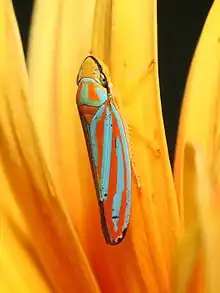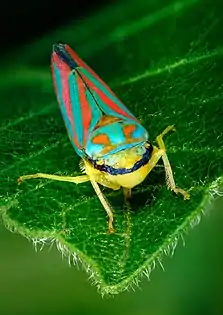| Graphocephala coccinea | |
|---|---|
 | |
| Scientific classification | |
| Domain: | Eukaryota |
| Kingdom: | Animalia |
| Phylum: | Arthropoda |
| Class: | Insecta |
| Order: | Hemiptera |
| Suborder: | Auchenorrhyncha |
| Family: | Cicadellidae |
| Genus: | Graphocephala |
| Species: | G. coccinea |
| Binomial name | |
| Graphocephala coccinea (Forster, 1771) | |
| Synonyms | |
Graphocephala coccinea is a meadow and woodland-dwelling species of brightly colored leafhopper native to North and Central America, from Canada south to Panama.[1] Common names include candy-striped leafhopper, red-banded leafhopper, scarlet-and-green leafhopper and red-and-blue leafhopper.
Adults measure 6.7–8.4 mm in length and have vivid blue (or green) and red (or orange-red) stripes on their wings and the top of their thorax combined with bright yellow coloration on their head, legs, abdomen, and elsewhere.
Leafhoppers feed on plant sap with the aid of specialized mouthparts.

Pierce's disease

G. coccinea has been identified as one of several leafhopper species that is a vector in leaf scorch caused by the gammaproteobacteria Xylella fastidiosa ("Pierce's disease"). X. fastidiosa is responsible for the decline of certain woody plants such as elm, oak, and other ornamental trees.[2] According to a research entomologist at the United States National Arboretum, "An understanding of the transmission of this bacterium by insect vectors is economically important because there is neither any known effective therapy for infected trees and shrubs nor a strategy for preventing infection."[3] In California they damage valuable crops[4] and in Germany they are a nuisance to people sitting under trees in public parks.[5]
Subspecies
At least three subspecies of G. coccinea have been named: G. coccinea confluenta, G. coccinea punctata, and G. coccinea sambuci (all Olsen 1918).[1]
References
- 1 2 United States Department of Agriculture Archived 2008-09-22 at the Wayback Machine
- ↑ USDA Agricultural Research Service
- ↑ Dr. Jo-Ann Bentz, Research Entomologist
- ↑ Jeger, Michael; Caffier, David; Candresse, Thierry; Chatzivassiliou, Elisavet; Dehnen‐Schmutz, Katharina; Gilioli, Gianni; Grégoire, Jean‐Claude; Jaques Miret, Josep Anton; MacLeod, Alan; Navajas Navarro, Maria; Niere, Björn; Parnell, Stephen; Potting, Roel; Rafoss, Trond; Rossi, Vittorio; Urek, Gregor; Van Bruggen, Ariena; Van der Werf, Wopke; West, Jonathan; Winter, Stephan; Almeida, Rodrigo; Bosco, Domenico; Jacques, Marie‐Agnès; Landa, Blanca; Purcell, Alexander; Saponari, Maria; Czwienczek, Ewelina; Delbianco, Alice; Stancanelli, Giuseppe; Bragard, Claude; Bragard, C (July 2018). "Updated pest categorisation of Xylella fastidiosa". EFSA Journal. 16 (7): e05357. doi:10.2903/j.efsa.2018.5357. PMC 7009507. PMID 32625990.
- ↑ Nikusch, I. W. (1992). "Die Platanennetzwanze, Corythuca ciliata Say, und die Rhododendronzikade, Graphocephala coccinea Forster, zwei neuere sich ausbreitende Problemschädlinge für das Öffentliche Grün in Deutschland" [The sycamore lace bug, Corythuca ciliata (Say) and the rhododendron leafhopper Graphocephala coccinea (Forster), two new, spreading problem pests in public green spaces in Germany]. Gesunde Pflanzen (in German). 44 (9): 311–315.
External links
 Media related to Graphocephala coccinea at Wikimedia Commons
Media related to Graphocephala coccinea at Wikimedia Commons